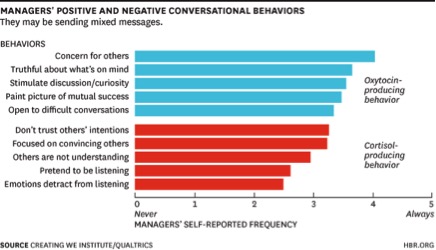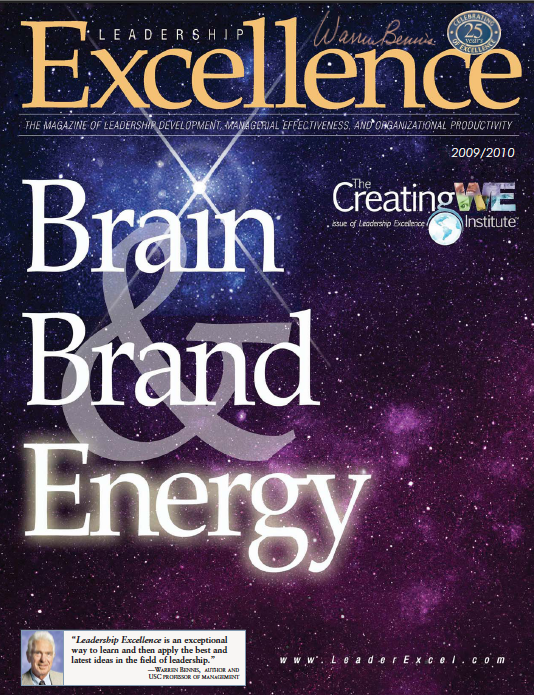By Judith E. Glaser & Richard D. Glaser | excellenceessentials.com
Published: November 20, 2014
Practice "mind opening" psychology in your teams and organizations
Why do negative and judgmental comments and conversations—especially from people in positions of authority—stick with us so much longer than positive ones?
Once I coached a senior executive from Verizon, Rob, who thought of himself as a “best practices” leader who told people what to do, set clear goals, and challenged his team to produce quality results. But when one of his direct reports had a heart attack and three others asked HR to be transferred off his team, Rob realized there was a problem.
After observing Rob’s conversational patterns for a few weeks, I saw clearly that his negative behaviors (which produce cortisol) easily outweighed his positive behaviors (which produce oxytocin). Instead of asking questions to stimulate discussion, showing concern for others, and painting a compelling picture of shared success, he tended to tell and sell his ideas, entering most discussions with a fixed opinion, determined to convince others he was right. He was not open to others’ influence; he failed to listen to connect.
When I explained this to Rob and told him about the chemical impact of his behavior on his employees, he vowed to change, and it worked. A few weeks later, a member of his team even asked me: “What did you give my boss to drink?”
The Job of Rob (and all Managers)
A critique from a boss, a disagreement with a colleague, a fight with a friend—the sting from any of these can make you forget a month’s worth of praise or accord. If you have been called lazy, careless, or a disappointment, you’re likely to remember and internalize it. It’s somehow easier to forget or discount all the times people have said you’re talented or conscientious or that you make them proud.
Chemistry plays a big role in our conversational interactions. When we face criticism, rejection or fear, or when we feel marginalized or minimized, our bodies produce higher levels of cortisol, a hormone that shuts down the thinking center of our brains and activates conflict aversion and protection behaviors. We become more reactive and sensitive. We often perceive even greater judgment and negativity than actually exists. And these effects can last for 26 hours or more, imprinting the interaction on our memories and magnifying the impact it has on our future behavior. Cortisol functions like a sustained-release tablet—the more we ruminate about our fear, the longer the impact.
Positive comments and conversations produce a chemical reaction, too. They spur the production of oxytocin, a feel-good hormone that elevates our ability to communicate, collaborate, and trust others by activating networks in our prefrontal cortex. But oxytocin metabolizes more quickly than cortisol, so its effects are less dramatic and less long-lasting.
This chemistry of conversations is linked to a whole new science of what opens up and closes down our minds, hearts, and brains to other human beings and to the world around us. When our minds are triggered by fear we close down and move into protect behavior. Trigging can take place in a nanosecond, which we now know can be a fast as .07 seconds. When our lower brain—or amygdala—is threatened, the levels of cortisol rise, which creates an immediate "shut down" of our prefrontal cortex— our "executive brain" that enables strategic thinking, empathy, connectivity with others, innovative thing, and most of all, trust. When we are in an "extreme trigger," we get what is called an "amygdala hijack."
Seven Universal Threats That Give Us an Amygdala Hijack:
- Tone threat—judgmental or angry tone is felt as a threat to our ego
- Hurt threat—threat to our physical safety and to our ego
- Risk of rejection threat—fear of failure or making mistakes and being rejected
- Exclusion threat—looking stupid in front of others and being ostracized
- Anger threat—fear of someone’s anger toward us and not knowing how to respond
- Territory threat—having our territory limited or diminished, or encroached
- Status threat—challenge to our status or making us feel small
That’s why it’s so critical for all of us—especially managers and leaders—to be more mindful about our interactions and more conscious about our conversations and behaviors. In a fraction of a second, we can activate an extreme trigger (ET) and when we do, we cannot act intelligently—we are in a state of protection—or access our higher-thinking powers. Those behaviors that increase cortisol levels also reduce our conversational intelligence (C-IQ), our ability to connect and think innovatively, empathetically, creatively, and strategically with others. Behaviors that enable us to connect, collaborate, and co-create will spark oxytocin and boost C-IQ.
Amplifying Insight Through the Lens of Research
To amplify and explain what opens and what closes down our brains during conversations, my consultancy, The Creating WE Institute, partnered with Ryan Smith, CEO of Qualtrics, the world’s largest online survey software company, to analyze the frequency of negative (cortisol-producing) versus positive (oxytocin-producing) interactions in today’s workplaces. My goal was to find a way to examine and further understand the impact of conversations that enables companies to thrive or limits their growth. Over the past 30 years, I’ve helped leaders at companies including Boehringer Ingelheim, Clairol, Donna Karen, Exide Technologies, Burberry, and Coach learn to boost performance with better C-IQ during their most challenging business transformations. With the power of quantitative analytics, we added another dimension to bring insights to the conversations about conversations.
For our research, we asked managers how often they engaged in several behaviors—some which open our brain and others which close down our brain—on a scale of 0 through 5, where 0 was “never” and 5 was “always.”
Uncertainty Impacts Conversational Barriers...

Implications: Certainty and Uncertainty in Relationships and Conversations
Our research with 2,000 executives shows, that in general, people more frequently favor behaviors that produce more oxytocin than cortisol. Questions in blue open people up to trust and connect with each other, while questions in red close people down and cause distrust. Survey respondents said that they exhibited all five positive behaviors (e.g., showing concern for others) more frequently than all five negative ones (e.g., pretending to be listening). However, most respondents—about 85 percent—also admitted to “sometimes” acting in ways that could derail not only specific interactions but also future relationships. In fact, the breakdown of respondents' answers shows that some people exhibit the "cortisol producing behaviors" very frequently. Unfortunately, when leaders exhibit both types of behaviors, it creates dissonance or uncertainty in others’ brains, spurring higher levels of cortisol production and reducing CI-Q.
When we are in a state of uncertainty we begin to move back into fear, creating a cycle of distrust in the organization. Fear trumps trust because cortisol trumps oxytocin. The impact of cortisol is more far-reaching in our brain, an amazing organ that has evolved over the billions of years to protect us from harm.
When trust is absent, we see REALITY with threatened eyes, and we:
- Reveal less than what we know or what is helpful to move forward
- Expect more than what is possible
- Assume the worst in others
- Look at situations with caution
- Interpret communications with fear
- Tell secrets we promised not to tell
- Yes people to avoid confronting truth
When we are in a state of uncertainty and distrust, the world feels threatening. Threats make us retreat and feel the need to protect. We are more sensitive to feeling wrong or embarrassed, and we behave differently.
I’m not suggesting that we can’t ever demand results or deliver difficult feedback. But we need to do so in a way that is perceived as inclusive and supportive to limit cortisol production and stimulate oxytocin production.
Be mindful of your words, body language, and behaviors that open people up, and those that close people down, in your relationships. To gain greater influence, harness both the chemistry and psychology of conversations.
1. Neuro-Tip #1: Trust is the feeling of "I am safe and I know you have my back." Trust is associated with the release of the neurotransmitter oxytocin, which is considered to be associated with love, bonding, collaboration, and elevating trust and is viewed, according to neuroscientists, as the expectation of benevolence. Distrust, on the other hand, is associated with the release of cortisol, the fear hormone, and is associated with the expectation of malevolence.
NEURO-INSIGHT: Our brain picks up signals of trust and distrust at the same time and is often in a state of uncertainty.
ACTION: When you want to build a healthy relationship, you can prime a conversation for higher levels of trust by priming for trust.
- Priming: Walk into a conversation with an open, non-judgmental mindset. That way, you can influence your own brain and that of others to choose to be influenced by the trust signals over the distrust signals.




